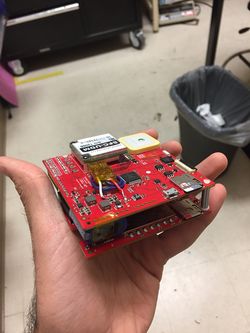VB Gen 8.1 Avionics
| ValBal Generation 8.1 Avionics | |
|---|---|
| Part of the ValBal series | |

| |
| Chief Designer | Aria Tedjarati |
| Technology Line | Balloons ValBal Architecture |
| Version | Generation 8.1 |
| Name | ValBaby |
The ValBal Gen 8.1 Avionics is the eighth generation and twelfth iteration of of the ValBal core electrical architecture. It is the most up-to-date and highest performing ValBal avionics version as of September 2017, consisting of two 3-inch by 3-inch FR4 PCB's that are stacked on top of one another above 33 AA non-rechargeable lithium primary batteries, in addition to a small breakout PCB that is exposed to the air. The architecture makes significant changes and improvements on the ValBal Generation 8.0 architecture, including changes in physical size, stacking connectors, power regulation and efficiency, cost, wireless communication, and more.
The details of the ValBal generation 8.1 avionics are outlined below in exhaustive detail.
Introduction
ValBal is an actively altitude-controlled, low-cost, high-endurance, autonomous latex high altitude balloon system. It requires a complex set of avionics hardware to enable it to complete its mission. In general, at a bare minimum, any ValBal avionics system must have the following set of features to ensure a successful flight.
- Half-duplex or full-duplex wireless communication
- Dual bidirectional high power motor control
- High altitude GPS location acquisition capability
- Power regulation and subsystem protection
- Temperature regulation
- Barometric pressure & temperature sensing, filtering, and error detection
- Powerful microprocessor with autonomous flight code
- Current & voltage sensing of all system parameters
- Weigh no more than approximately 1 kilogram
- Have a form factor of less than 3 x 3 x 6 inches
The 8.1 generation of ValBal avionics goes above and beyond these minimum requirements.
Mainboard
Microcontroller
Power Handoff
Power Regulation and Control
Current Sensing
Voltage Sensing
Temperature Sensing and Regulation
Barometric Pressure Sensing
Valve and Ballast Motor Control
GPS
Two-way Satellite Communication
Data-logging
Firmware
Connectors
Radio Board
The purpose of the ValBal v8.1 Radio Board is to act as an independent payload that interfaces with the ValBal v8.1 Mainboard, and is responsible for all of ValBal's radio communication to and from the ground excluding satellite communication. It is an additive board, meaning that it is not flight critical and is not necessary for a ValBal flight to be successful. However, its inclusion in the ValBal avionics allows for significant advantages over a simple "Mainboard-only" system due to the extremely slow speeds and bandwidth of the Iridium satellite communication system. The ValBal v8.1 Radio Board allows for transmission speeds of over 100,000 times that of the Iridium system, enabling flight controllers on the ground to receive much more data more quickly in the form of flight telemetry, pictures, videos, music, and automated packets, at the expense of power, weight, and cost. The board has two transceivers: one is responsible for transmitting and receiving Ultra-High-Frequency (UHF) digital data modulated with GFSK, FSK, or OOK, and the other is responsible for transmitting and receiving Very-High-Frequency (VHF) analog data modulated with FM.
Microcontroller
The micro-controller onboard the ValBal v8.1 Radio Board is an embedded Teensy 3.2 (identical to the Mainboard except it uses 0603 sized components instead of 0402).
Power Regulation and Control
The power regulation and control of the ValBal v8.1 Radio Board is identical to that of the Mainboard except with a few additions. First, the Radio Board has three super-capacitors in parallel in order to store more energy. The total amount of usable energy in the capacitors is 1/2*(15F)*(5V)^2 - 1/2*(15F)*(2V)^2 = 157.5 Joules. This means that, for example, if we drew a continuous 2.5W of power from the capacitors (assuming no charging), we would have approximately 63 seconds of usable energy time. Second, none of the subsystems on the Radio Board run off of 5V - the closest thing with high current draw is the VHF radio (nicknamed Dorji) that needs 4V. Therefore, after the 5V buck-boost regulator there is a 4V LDO linear regulator that feeds into the Dorji system. Finally, the last difference is that by default the Radio Board charging circuitry charges the super-capacitors as slowly as possible (i.e. minimum current limit is 100mA) to avoid damaging the batteries.
UHF Transceiver and Antenna
Runs on SPI. Takes 3.3V as an input. Can modulate with 4GFSK, 2GFSK, 2FSK, or OOK. -30 dBm to +20 dBm output RF power. We use it at 435 MHz. 30 MHz TCXO. Current draw 20mA recv 90mA tx. Independent of supercaps. Bandwidth programmable. Can choose between Zero-IF, Fixed-IF, and Scaled-IF. Receiver sensitivity changes with a lot of things. BER? Chip has own LO and does mixing itself. Single ended tx output. Matching. Low pass filtering. Choke inductor for power. Receiver is differential --> needs balun/match. Direct tie. Single antenna.
VHF Transceiver and Antenna
Communicates on UART. Takes 4V as an input. DAC input from MCU is mixed with LO in chip